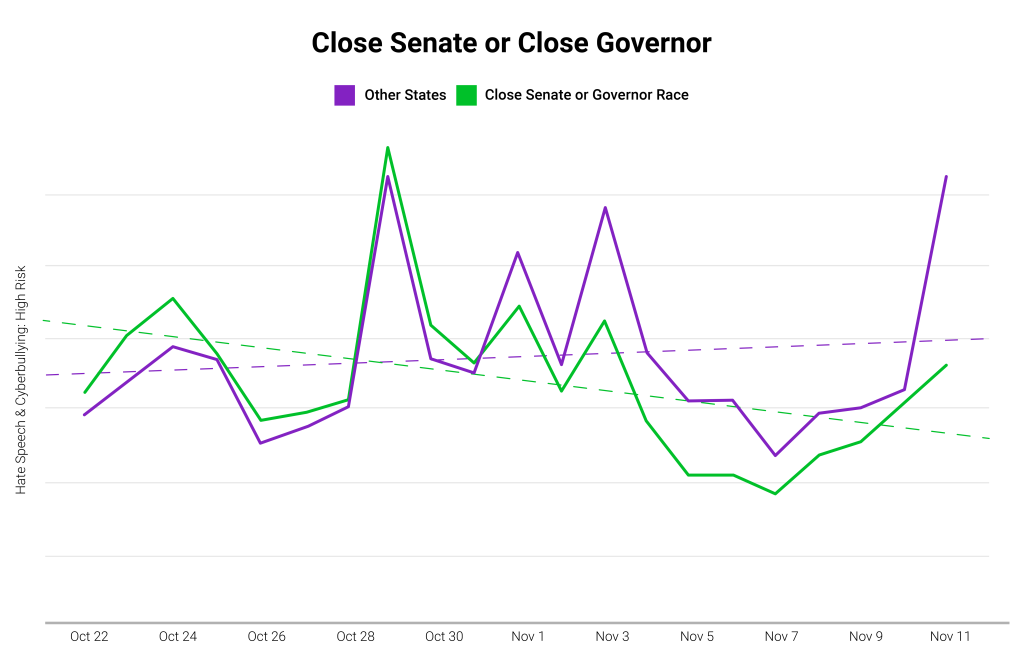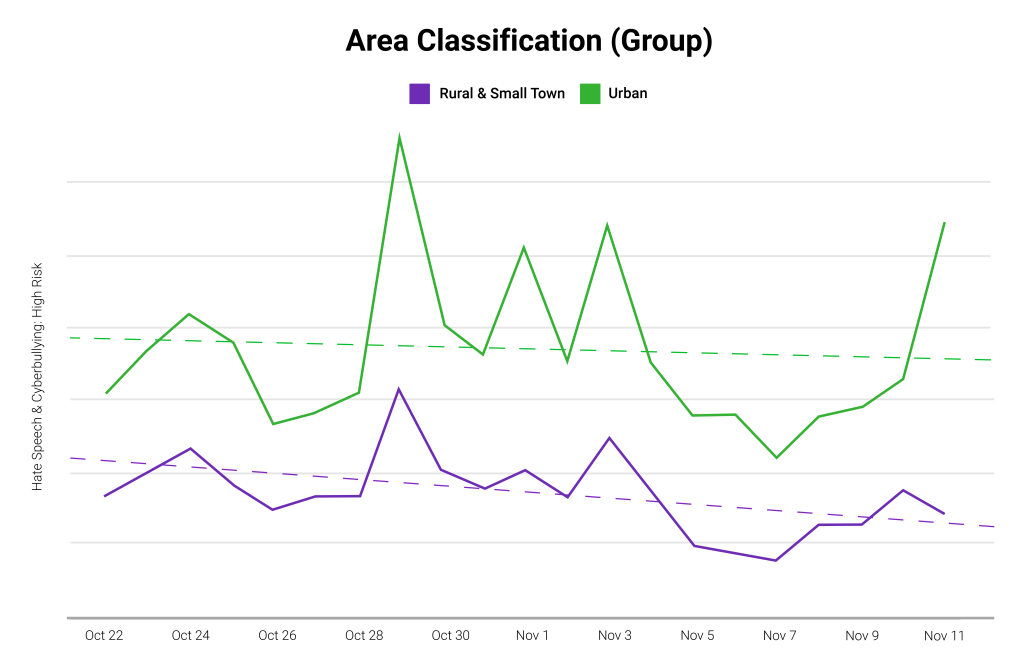High-Risk Hate Speech rates declined over the week of November 5 – November 11 for the first time since the DoubleVerify (DV) Election Task Force began tracking content related to the U.S. midterm elections. Across all states, the High-Risk Speech rate during U.S. midterm election week fell by 29.5% relative to the rate during the previous week (October 29 – November 4).
Read on for a detailed analysis of trends across hate speech, inflammatory politics and news and content surrounding the top 10 midterm voting issues (per Pew Research) during election week.
High-Risk Hate Speech Snapshot
Although the rate of High-Risk Hate Speech generally decreased overall across all states, this past week did see one very pronounced spike evident over November 10 – November 11. This spike coincides with news following the U.S. midterm election results, as well as Phil Knight’s announcement that Nike was ending their sponsorship deal with Kyrie Irving over a video he posted with anti-semitic disinformation.
High-Risk Hate Speech Rates (States with Close Statewide Elections vs. All Other States)

The decrease of the High-Risk Hate Speech rates also varied between states with close Senate or Governor races versus all other states; states with close races saw a more drastic dip, where rates fell by 29%, as compared with other states where rates fell by 24%.
Key Takeaways
Throughout October, the DV Election Task Force noted a disparity in High-Risk Hate Speech rates between urban and rural areas (as classified by U.S. census data). Although rates declined in both areas during the week of November 4 – November 11, the disparity persisted. High-Risk Hate Speech declined by 30% week-over-week in urban areas and 43% week-over-week in rural areas. The rate of High-Risk Hate Speech was 162% higher in urban areas versus rural areas during election week.
High-Risk Hate Speech Rates (Urban Areas vs. Rural Areas)

Topics Surrounding the Midterm Elections – and Those Prevalent Across Inflammatory Politics and News
During election week, abortion content was once again the most prevalent topic with DV-tracked midterm election content of the top voting issues (per Pew Research). The percent pages mentioning violent crime decreased to 25%, from 29% the week prior, but this remained the second most prevalent topic for the second week running. And the percentage of pages mentioning the economy ticked up to 24%, from 20% the week prior.

Among the pages DV sampled that were categorized as Inflammatory Politics and News, violent crime remained the most prevalent. The economy and energy policy reversed places, with the economy becoming the second most prevalent and energy policy the third.

Top 5 States for High-Risk Hate Speech and Inflammatory Politics and News
The latest geographic ranking of High-Risk Hate Speech and Inflammatory Politics and News by rate during the week of November 5 – November 11 shows New York and Ohio with the most in each category, respectively, for the second week in a row. Previously, from October 5 – October 28, Mississippi and Wyoming ranked the highest for High-Risk Hate Speech and Inflammatory Politics and News, respectively.
Top 5 High-Risk Hate Speech States:
-
- New York
- Illinois
- Georgia
- Arizona
- Virginia
Top 5 Inflammatory Politics and News (IPN) States:
-
- Ohio
- West Virginia
- Maryland
- Arizona
- Montana
As the Georgia Runoff and 2024 Primaries Approach
Although the U.S. midterm elections are over, the Georgia senate runoff will be held on December 6 and primary races for 2024 are already being discussed. The DV Election Task Force will continue monitoring the situation in real-time. And in our next installment, the Task Force will take a look at data across Georgia.
If you have questions about brand safety and suitability as it pertains to the election news cycle, please reach out to Sales@DoubleVerify.com.
Appendix
DV analyzes billions of impressions a day spanning websites, mobile apps, message boards and blogs to help keep brands safe from appearing alongside content they deem unsafe or unsuitable. Publishers promoting specious or racially biased/motivated claims are classified into DV’s Inflammatory Politics and News and Hate Speech categories.
DV’s ongoing analysis of category traffic rates associated with High-Risk Hate Speech began on August 1 and compares states with close Senate and Gubernatorial races to those without any close races. Between August 1 and August 22, the average rate of High-Risk Hate Speech was the same for both subsets of states. As the midterm election cycle went into full swing, we observed that the average rate of High-Risk Hate Speech increased markedly.
How DV Defines Close Races, Rural and Urban Areas and Top Voting Issues
Close Races: DV’s list of close races is composed of “battleground” races identified by the nonprofit and nonpartisan online political encyclopedia Ballotpedia.
Rural and Urban Areas: The subgroups we designated as “urban” and “rural & small town” were derived using the rural-urban commuting area code (RUCA) classifications from the US census, listed as: metropolitan, micropolitan, small town and rural. Any areas designated metropolitan and micropolitan were grouped as “urban” in our analysis, while the remaining areas were grouped as “rural & small town.”
Tracking Topics Among Election-Related and Inflammatory Politics and News Web Pages
The DV ontology team uses machine learning to analyze web page content and identify topics being discussed. This capability allowed DV’s task force to track the frequency and prevalence of specific topics being mentioned over time.
Beginning in mid-September, the ontology team identified pages where midterm elections were mentioned and tracked the percentage of pages where the top 10 midterm voting issues appeared (i.e. % of total sample). The top 10 voting issues we tracked (per Pew Research) are listed here alphabetically:
- Abortion
- Economy
- Education
- Energy Policy
- Gun Policy
- Health Care
- Immigration
- Supreme Court Appointments
- Violent Crime
- Voting Policy
Beginning the week of September 24 – September 30, DV began analyzing the percentage of pages that mentioned these topics and were also categorized as Inflammatory Politics and News.
Glossary of Terms
Category Traffic Rates: Category traffic rates are defined as the percentage of all DV monitored ad calls that were adjacent to content classified within a specific category. This serves as a proxy for overall traffic trends.
Hate Speech/Hate Speech & Cyberbullying (overall category definition): These terms may be used interchangeably and refer to content that is related to biased, derogatory, or offensive actions towards any individuals or groups. Content that may incite violence against individuals or groups within a protected class is also within the category.
- Please note, the overall category is not limited to instances of harmful language or behavior; it also includes content about such language or behavior, such as news coverage about a hate crime or cyberbullying, as well as content about groups that are associated with such activities.
High-Risk Hate Speech/Hate Speech & Cyberbullying (High Risk): These terms may be used interchangeably and refer to content that includes hate speech or derogatory terms in a demeaning, harmful manner; discussion of hate crimes, hate groups, hate speech, and cyberbullying in user-generated and/or unmoderated content; content that promotes or glorifies hate groups; content that provides information on how to commit cyberbullying or hate crimes; content that is related to biased, derogatory or offensive actions towards any individuals or groups; content that may incite violence against individuals or groups within a protected class is also within the category.
Inflammatory Politics and News: News or political content associated with or exhibiting inflammatory points of view; potentially fake, unreliable or unsubstantiated information; significant political intolerance, hateful or threatening rhetoric; or other significantly controversial elements.
Previous Election Coverage

